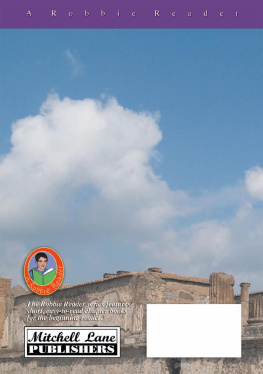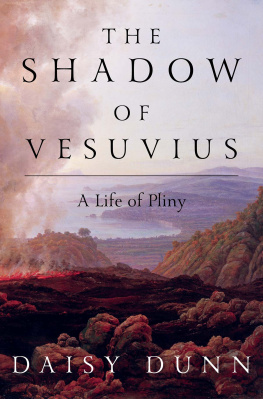Pedar W. Foss - Pliny and the Eruption of Vesuvius
Here you can read online Pedar W. Foss - Pliny and the Eruption of Vesuvius full text of the book (entire story) in english for free. Download pdf and epub, get meaning, cover and reviews about this ebook. year: 2022, publisher: TaylorFrancis, genre: Detective and thriller. Description of the work, (preface) as well as reviews are available. Best literature library LitArk.com created for fans of good reading and offers a wide selection of genres:
Romance novel
Science fiction
Adventure
Detective
Science
History
Home and family
Prose
Art
Politics
Computer
Non-fiction
Religion
Business
Children
Humor
Choose a favorite category and find really read worthwhile books. Enjoy immersion in the world of imagination, feel the emotions of the characters or learn something new for yourself, make an fascinating discovery.
- Book:Pliny and the Eruption of Vesuvius
- Author:
- Publisher:TaylorFrancis
- Genre:
- Year:2022
- Rating:4 / 5
- Favourites:Add to favourites
- Your mark:
- 80
- 1
- 2
- 3
- 4
- 5
Pliny and the Eruption of Vesuvius: summary, description and annotation
We offer to read an annotation, description, summary or preface (depends on what the author of the book "Pliny and the Eruption of Vesuvius" wrote himself). If you haven't found the necessary information about the book — write in the comments, we will try to find it.
Pliny and the Eruption of Vesuvius — read online for free the complete book (whole text) full work
Below is the text of the book, divided by pages. System saving the place of the last page read, allows you to conveniently read the book "Pliny and the Eruption of Vesuvius" online for free, without having to search again every time where you left off. Put a bookmark, and you can go to the page where you finished reading at any time.
Font size:
Interval:
Bookmark:

Pliny and the Eruption of Vesuvius is a forensic examination of two of the most famous letters from the ancient Mediterranean world: Pliny the Youngers Epistulae 6.16 and 6.20, which offer a contemporary account of the eruption of Vesuvius in AD 79.
These letters, sent to the historian Tacitus, provide accounts by Pliny the Younger about what happened when Mt Vesuvius exploded, destroying the surrounding towns and countryside, including Pompeii and Herculaneum, and killing his uncle, Pliny the Elder. This volume provides the first comprehensive full-length treatment of these documents, contextualized by evidence-rich biographies for both Plinys, and a synthesis of the latest archaeological and volcanological research which answers questions about the eruption date. A new collation of sources results in a detailed manuscript tradition and an authoritative Latin text, while commentaries on each letter offer copiously referenced insights on their structure, style, and meaning.
Pliny and the Eruption of Vesuvius offers a thorough companion to these letters, and to the eruption, which will be of interest not only to those working on Vesuvius, Pompeii, and Herculaneum, and the works of Pliny but also to general readers, Latin students, and scholars of the Roman world more broadly.
Pedar W. Foss is Professor of Classical Studies at DePauw University in Greencastle, Indiana (USA). He is co-editor, with John J. Dobbins, of The World of Pompeii (Routledge 2007) and is an archaeologist who works on the ancient Bay of Naples and landscape archaeology. He has done fieldwork in Greece, Turkey, Tunisia, and Italy, and received his Ph.D. in Classical Art and Archaeology from the University of Michigan.
Pedar W. Foss

First published 2022by Routledge4 Park Square, Milton Park, Abingdon, Oxon OX14 4RN
and by Routledge605 Third Avenue, New York, NY 10158
Routledge is an imprint of the Taylor & Francis Group, an informa business
2022 Pedar W. Foss
The right of Pedar W. Foss to be identified as author of this work has been asserted in accordance with sections 77 and 78 of the Copyright, Designs and Patents Act 1988.
All rights reserved. No part of this book may be reprinted or reproduced or utilised in any form or by any electronic, mechanical, or other means, now known or hereafter invented, including photocopying and recording, or in any information storage or retrieval system, without permission in writing from the publishers.
Trademark notice: Product or corporate names may be trademarks or registered trademarks, and are used only for identification and explanation without intent to infringe.
British Library Cataloguing-in-Publication DataA catalogue record for this book is available from the British Library
Library of Congress Cataloging-in-Publication DataA catalog record has been requested for this book
ISBN: 978-0-415-70546-2 (hbk)ISBN: 978-1-032-22541-8 (pbk)ISBN: 978-1-003-27302-8 (ebk)
DOI: 10.4324/9781003273028
Typeset in Times New Romanby Deanta Global Publishing Services, Chennai, India
Access the Support Material: https://www.routledge.com/9780415705462
To Rebecca and Jenni
In memoriam:Eleanor Winsor Leach (19372018)H. Don Cameron (19342021)Major John Swerda (19152005)
Online Resources: https://www.routledge.com/9780415705462
In of her novel The Last Samurai, Helen DeWitts heroine Sibylla promotes the marvelously daffy idea of fashioning multiple Rosetta Stones for the world books that would encapsulate and encompass the knowledge of works in other languages, while providing the linguistic keys to unlock and explain them. Sibylla argues that this would preserve other languages to posterity. You could have Homer with translation and marginal notes on vocabulary and grammar, so that if that single book happened to be dug up in 2,000 years or so, the people of day would be able to read Homer I read this novel in the year 2000, when I was coproducing The World of Pompeii with John Dobbins. More than a decade later, upon assigning her book at DePauw, I reread the passage and realized that this was what a long-gestating project was about. The thought had tickled me to tackle Pliny the Youngers two letters about the eruption of Mt. Vesuvius in AD 79 (Epistulae 6.16 and 6.20), in which his uncle Elder Pliny died, and which appear in practically every scholarly and popular account about Pompeii. Commentary seemed to have gone stale; too many studies tended to repeat others conclusions without critical evaluation of the original sources. These letters appeared to be some of the most reproduced, yet least fundamentally understood, passages to survive from classical antiquity. Sibyllas challenge beckoned.
Scholars have not ignored these letters; quite the opposite, given the recent and brilliant renaissance in Plinian studies, which has tended to examine either Plinys sociocultural-historical world or his literary world and, recently, their intersection. Scientific teams have also reassessed the dynamics and characteristics of the Vesuvian eruption and its effects on the populations, settlements, and landscapes around the Bay of Naples. What hasnt existed, however, is a multidisciplinary assessment: the conditions of the letters creation, their journey through the medieval manuscript tradition, and the minute details of their content, in the spirit of our modern extremist mode of close reading, as John Henderson puts it.
This is not a book about the buried cities of Pompeii and Herculaneum, although those appear in the course of analysis. Pliny mentions neither place. This book is about the two letters and their people: who made them happen, for whom they were written, who feature in their stories, and who copied them for centuries after ancient Rome had shrunk to a medieval village. This book is also about those who rediscovered, collated, compiled, and commented upon the early scholarly editions of the texts, who applied the letters to the new archaeological discoveries of the 18th-century Bay of Naples, and whom the letters inspired to fashion works of art about two ashy days and a night.
Recently, Gibson, Marchesi, Whitton, and Woolf have discussed recent scholarly treatments of Plinys letters as gathering in literary (including intertextual), historical, realist, or instrumentalist categories. Like those authors, I agree that such categories are useful and that they bleed into each other. My approach tries to encompass these, but in an archaeological (by which I mean both highly interdisciplinary and sequenced) way. I examine the letters as artifacts, consider their interleaved social, historical, political, literary, cultural, personal, and use contexts while reading the story as something that (more or less) happened to actual people in late AD 79. By examining every angle and cranny of the text, by looking around verbal corners, can we discern what influenced the Youngers narrative choices, how he blended memory and history with the opportunity to embellish events, polished a portrait of the Elder, and made his own literary statement? Can we reconstruct the kind of world in which he was living (as he watched others go mad or die)? What did either Pliny comprehend at the time of the event? What spun through the Youngers head when, over the years, others asked him what had happened? Finally, what did he come to understand as he composed the letters and revised them for publication?
Next pageFont size:
Interval:
Bookmark:
Similar books «Pliny and the Eruption of Vesuvius»
Look at similar books to Pliny and the Eruption of Vesuvius. We have selected literature similar in name and meaning in the hope of providing readers with more options to find new, interesting, not yet read works.
Discussion, reviews of the book Pliny and the Eruption of Vesuvius and just readers' own opinions. Leave your comments, write what you think about the work, its meaning or the main characters. Specify what exactly you liked and what you didn't like, and why you think so.













